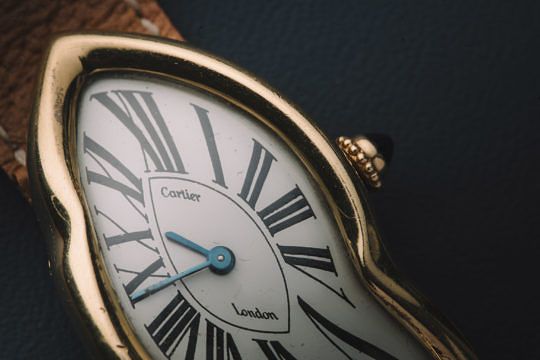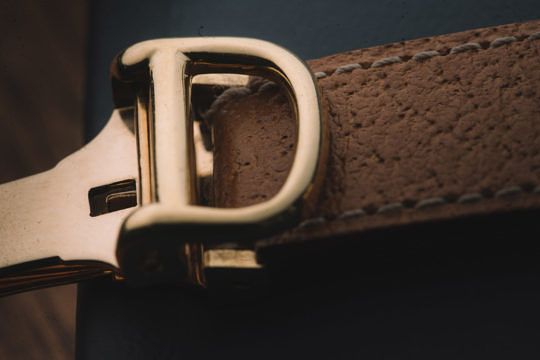Cartier A large, extremely rare and very fine yellow gold asymmetrical wristwatch, circa 1987
Many have imagined a story for the Crash, each one an attempt to explain how Cartier conceived such a surreal watch. Some believe it was the jeweler's attempt to reproduce the distorted clocks in Salvador Dalí's famed painting, The Persistence of Memory. Others, inspired by the watch's name rather than its shape, suggested a more macabre story: rumors that the watch was, in fact, a Baignoire that had melted after being engulfed in the flames of a burning car have been hard to dispel.
Somehow, the idea that one of the greatest design houses had not made this watch deliberately became a plausible theory, and the legend of the Crash was born. Yet, many of Cartier's most eccentric watches can be traced back to one address, in London. For a period of 43 years, Cartier London produced watches its way, adapting the jeweler's strict visual identity for a more relaxed clientèle. And during the Swinging Sixties, this led to some surprising watches.
Jean-Jacques Cartier, the great-grandson of the company's founder, succeeded his father in London, and ran Cartier's British outpost from 1945 to 1974, during a period marked by exceptional creative freedom. The Paris, London and New York branches of Cartier were operated separately, allowing for independent styles to emerge under a single brand name.
And the most influential artisans, during the 1960s and 1970s, were the ones in London, including one Rupert Emmerson, who played with Cartier's visual identity, stretching and bending it with much more audacity than his predecessors. In fact, a much more plausible origin story for the Crash is that Emerson simply thought about twisting the case of an Oblique, another London creation – this one from the 1930s – and a watch that defined the thirties and which he would have wanted to make more relevant.
The original Crash was exceptional, not just for its shape, but also its size. The style and proportions of the watches made in London set them apart from their French siblings. The London Crash was 43mm long and 25mm wide, which is larger than most Cartier models, including the majority subsequent Crash watches.
A few years ago, one of Emmerson’s former colleagues revealed to author Nicholas Foulkes that Mr. Cartier had originally dismissed the Crash, but the reaction it received when shown to local clients convinced him to release the piece in 1967.
London Crash watches were exclusively made by hand, the numerals painted once Cartier's master watchmaker had fitted the movement inside the case. The earliest models were powered by a manually-wound LeCoultre movement, signed Cartier and supplied by New York.
Jean-Jacques Cartier stepped down from Cartier when the three branches were reunited in 1970s, but Cartier London kept producing its most well-known models, including the Crash, the Maxi Oval and the Tank Cintré, by hand and upon request. In 1991, Cartier Paris launched its own, smaller, version of the Crash, in a limited series of 400, and London Crash watches were retired three years later, making this of the ultimate examples to have been made.
This particular watch from our upcoming WINNING ICONS sale in New York, a stunning yellow gold example, was a special order, made in Bond Street around 1987, a date which is confirmed by the hallmarks on the caseback and original Cartier buckle. However, the case metal, size, and dial with "London" signature recall the early models, and make this a particularly desirable version of the Crash.
Thirty years after its production, this watch is exactly as you would want to find it, in excellent condition with an unpolished case and a very nicely aged dial, with only light oxidation around the edges revealing its true age.
An icon of the swinging sixties, the Crash remains, not just one of the most surprising designs of the 20th century but one of the greatest.




